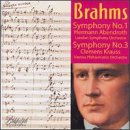| All Artists: Brahms, Lso, Abendroth, Krauss Title: Symphony 1 in C Minor Op 68 / Sym 3 in F Op 90 Members Wishing: 0 Total Copies: 0 Label: Biddulph Records Release Date: 2/9/1999 Genre: Classical Style: Symphonies Number of Discs: 1 SwapaCD Credits: 1 UPC: 744718305223 |
Search - Brahms, Lso, Abendroth :: Symphony 1 in C Minor Op 68 / Sym 3 in F Op 90
 | Brahms, Lso, Abendroth Symphony 1 in C Minor Op 68 / Sym 3 in F Op 90 Genre: Classical
|
Larger Image |
CD Details |
CD ReviewsBurnished Brahms of Bygone Days Thomas F. Bertonneau | Oswego, NY United States | 07/25/2000 (4 out of 5 stars) "Hermann Abendroth belonged to the same generation of German conductors as Wilhelm Furtwangler and Bruno Walter. Abendroth, like Furtwangler, was an unapologetic romantic, and he brought his romantic's sense of the work of art as a living organism to the Brahms symphonies, which he conducted throughout his life. Abendroth's 1927 Brahms First Symphony with the London Symphony Orchestra treats the score as an essay in angst, atunement, and vindication. The first movement's opening bars are stormy and driven, its quiet closing bars hushed and mysterious. The gradual build-up to the "chorale" theme in the fourth movement is dramatic and full of expectation. Everywhere Abendroth engages in the pushing and pulling of tempi (it's called rubato) that characterizes the German interpretive style of the first half of this century. They don't do Brahms this way anymore, and too bad. Some buyers of CDs stay away from archival recordings. They want technically up-to-date sound. The old electrical recordings, set down on large acetate discs, are certainly different in their acoustic properties than modern recordings, but I am by no means convinced that they are inferior. The sound is different, less defined, but maybe more natural, sounding as it might if heard from the seats at the back of the balcony. The Biddulph engineers have extracted the maximum of acoustic information from their sources. I find it a rewarding musical experience. It tells me a good deal about the music that I do not learn from modern recorded performances. This CD also contains a performance of the Brahms Third under Clemens Krauss." From the review in Gramophone Record Collector | Mons, Belgium | 11/23/2005 (5 out of 5 stars) "Thank heavens for such independent labels as Biddulph, Tahra, Dante Lys, Pearl, Dutton, APR and others like them, for were it not for their sterling efforts, performances such as these would be lost with the passage of time. And what valuable recordings they are. Much as we prize the Brahms of Furtwangler, Toscanini, Klemperer and Walter, anyone with active critical faculties-- and the ability to listen through old sound--is likely to enjoy Krauss or Abendroth virtually as much. Both conductors reflect a performing style that, as annotator Martin Leigh rightly suggests, might well have been recognized by the composer himself. Flexibility is a constant attribute, though the orchestras featured produce very different pooled sonorities.
Hermann Abendroth succeeded the Brahmsian conductor Fritz Steinbach as director of the Cologne Gurzenich concerts, and was in turn succeeded by Furtwangler at Leipzig. A good many of Abendroth's post-war East German recordings have latterly found their way on to CD, but most collectors will have first encountered the conductor through these 1927-8 Brahms 78s with the LSO. The original sound quality, although generally well balanced, is cramped and mono-dimensional, but Mark Obert-Thorn's painstaking transfers make the best of a difficult job. The First Symphony opens magisterially. Even as early as bar 9, a dip in tempo makes a dramatic effect, and at 5'29'' Abendroth purposely softens the ben marcato violas so as to maximize the mounting tension thereafter. The main body of the first movement is pliable but energetic, whereas the Andante sostenuto second movement flows nicely and the finale generates considerable visceral excitement. Like Sir Charles Mackerras (who himself on his Telarc set of Brahms had taken various of Steinbach's interpretative suggestions on board), Abendroth leans on the initial upbeat of the big string tune then pushes forwards. Just occasionally the tempo seems too fast for comfort, but the sum effect of Abendroth's approach is rugged and impulsive, somewhat like Furtwangler's but less artfully distended--especially in the pizzicato passages earlier on in the movement. The LSO's strings are more expressive than their rather acid woodwinds, the cellos being especially fine. Most of Brahms's dynamics are faithfully observed, and I would concur with Leigh that `Abendroth's treatment of the interrelationship of the movements is as perceptive as one would expect from a skilled opera conductor.` Clemens Krauss was even more celebrated as an opera conductor than Abendroth, and his symphonic records are few and far between. This 1930 Vienna Philharmonic account of the Third is distinguished by taut string playing, glorious contributions from the horn section (note how they shine resplendent prior to the first movement's recapitulation) and an unselfconscious approach to rubato. I could easily imagine that anyone who learned the Andante from this recording will have found all subsequent versions pallid and unconvincing. Krauss's handling of the opening bars--where violas, cellos and basses answer woodwinds and horns--suggests the intimacy of chamber music. Rarely has the writing breathed more naturally, or the underlying sentiment been more precisely gauged. The Poco Allegretto third movement is flexible but mobile (not too slow), and although some of the finale's faster passages are a little uncoordinated, the driving force of Krauss's approach marks a telling contrast with the symphony's reflective coda. With fine transfers and expert annotation, these two CDs provide an invaluable historical supplement to existing Brahms symphony recommendations. You may not always agree with what you hear, and yet all four performances should significantly extend your knowledge of these wonderful works. " |

 Track Listings (8) - Disc #1
Track Listings (8) - Disc #1